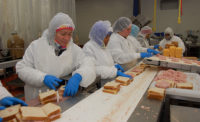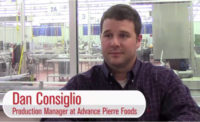When AdvancePierre Foods (APF) won The National Provisioner’s Processor of the Year award in June 2015, it was the first time in several years that the company had posted a profitable year — it was quite the turnaround and a major success story.
Yet, hidden in the shadows, one specter continued to occasionally haunt the company and some of its employees: its future. Private equity had owned the sandwich and protein processor for nearly eight years, and every now and then, rumors, whispers about the future of the company would pop up in news feeds and around the business.
That was until early 2016, when it was announced that Advance-Pierre Foods would file for an initial public offering (IPO), a process that eventually would stabilize the future of APF. John Simons, who will retire as CEO at the end of March 2017, says the IPO helped calm the worries of those thinking longer term.
“It created certainty about what the outcome would be,” he says. “And I think it energized the company in its own way. It became something very prideful in that people get to own it.”
George Chappelle, COO, says multiple circumstances weighed on the everyday worker, and relief was needed for the company to take the next step — the IPO provided just that.
“To go through the IPO and come out the other end not only as a public company, but as a public company that did very well through that process, the anxiety was reduced because the future is now known,” he adds. “Also, the whole notion of building up to the IPO, being a good enough company to go public, that question was answered.”
Read how APF has put the former Landshire Caseyville, Ill., plant on a stable track.Against the backdrop of the world economy, the IPO was well-timed, says Mike Sims, CFO, as it came on the heels of the Brexit news and post-Brexit return to the markets, at which time several blue-chip institutional investors were seeking new opportunities. This translated to a conversion rate on the investor meetings of approximately 70 percent and the shares being nearly 10 times oversubscribed during the IPO. The initial price of APFH shares was $21; by The National Provisioner’s presstime in mid-December 2016, shares were trading above $28.
Leading up to the IPO, APF management visited hundreds of potential investors, through which they were able to prioritize, fine-tune and focus on the strengths of APF. As investors began digging, four key questions surfaced that the company answered and used to its advantage to win over investors, Sims says.
The first focused on organic growth — how could APF sustain it? Sims says APF has targeted 2 to 3 percent growth of the base business per year before mergers and acquisitions, working to grow as fast as the segments in which the company operates and beating the competition in those areas.
Second, investors wanted to know how APF would sustain its margins after having done an above-average job against comparable food businesses. Sims pointed to the corporate culture as helping APF stay the course there.
“We’re not at peak margins, and we can sustain the margins we have and use our continuous improvement process called The APF Way [to improve],” he adds. “It helped us get where we are today, and it will be part of what we do going forward.”
Third, investors were impressed with APF’s ability to generate good cash flow, but they wanted to hear how the company would deploy that cash responsibly as a public company.
“We said we absolutely would be great stewards of cash, as we have been in the past,” Sims says. “We declared a dividend that we think is attractive and intend to maintain, but we have a lot of options with regard to cash: We can pay down our debt costs or even deploy it in high-return merger-and-acquisition activities.”
Finally, investors viewed APF as a natural consolidator in the food industry and requested insight into the acquisition discipline and strategy. APF pointed to its recent track record as a preview of the procedures moving forward. (Read about APF’s acquisition of Allied Specialty Foods, its most recent addition.)
Those answers turned into what APF calls the “Big Four” guidelines to create a total shareholder return of 10 to 12 percent.
“It’s something that investors liked a lot, because it looks a lot like what mature consumer product companies do today,” Sims says. “I think overall, though, people were astounded at the ability of APF to manage the degree of complexity in a constructive way, while still being cost-competitive.”
Chappelle concurs, saying APF’s ability to succeed with such an enormous scope of production demands created serious appeal beyond its potential as an acquirer.
“Our ability to distribute [2,600 SKUs] across the country to national customers and do it with the highest quality and 99 percent customer service — that we can behave like a very small, regional manufacturer, but on a national scale — resonated well,” he says. Additionally, the fact that APF wasn’t new to this game was not lost on most investors, explains Tony Schroder, president of Convenience.
“All of this [complexity] comes with a track record of performance,” he says. “I don’t think we would have gotten investors interested if we hadn’t performed really well for three years and transformed this company.”
Video Q&A: Dan Consiglio, production manager at APF, discusses how the company has driven success at the Caseyville, Ill. plant.The ability to customize solutions to meet demand, then translate them to larger production runs and maximize returns remains a hallmark of the strategy. According to Simons, this puts APF in a great spot.
“Some [CPGs] are trying to pitch one-size-fits-all products, and that’s not what a variety of customers in our segments wants,” he explains. “They want something that really drives consumer loyalty to them, and oftentimes that is a change from what a traditional CPG is willing to provide.”
Seeing this customization angle, investors asked APF how it dealt with all the complexity, and Chappelle’s answer was always two-fold.
“No. 1, we don’t avoid [complexity], we try to perfect it; that’s the methodology in our plants,” he says. “No. 2, we commercially reward ourselves for it; we feel as though we should be able to deliver that customization at a price premium and we often get it.”
That approach turns into a model by which margins grow, Sims explains, as APF then can be selective on customer size and type.
“Our job is not to be more cost-efficient than the massive CPG branded companies; it’s simply to be more cost-effective than our competitors for that customized business,” Sims says. “If you pick the right partners — the large-scale providers — you’re getting more scale in a highly fragmented industry, and you can have the best of both worlds.”
Chris Sliva, president (whose first day on the job came during The National Provisioner’s visit, and who will replace Simons as CEO at the end of March 2017), believes APF’s success starts with the willingness of employees to create and produce customized solutions that are unique, and then constantly look for ways to improve.
“My sense is, the same capabilities, the same foundation that served the company well over the last three years as a privately owned entity are the same things that will drive success,” Sliva says. “This team’s mission isn’t changing to a large degree, and it’s a tribute to how well they’ve built it that APF can make a change at the top and the organization doesn’t skip a beat.”
He believes the company has performed well deploying capital to drive growth and getting a return on that deployed capital — two things the market truly values.
“There’s an opportunity to accelerate the first one as we get our feet underneath us [as a public company], and the pieces that have been put together here already provide a great foundation as the source for growth and cash flow,” he adds. “Finally, we have an engine here in The APF Way that also delivers a return on capital that we certainly will continue to drive down the path we’re on.”
As Simons prepares to hand the reins to Sliva and move to the board of directors, there is nothing but mutual admiration among the members of the APF management team. Each of them, however, says they’d be mistaken to not embrace change, as they preach it to their workforce every single day. For his part, Simons contends — as he always has — that the team has been the driving force behind the successful turnaround and IPO.
“I think the very fact that Chris was willing to join APF validates this team and its potential to be even better in the future,” Simons says. “I’m professionally and personally thrilled that this very deserving team will have someone of his stature, knowledge and capability leading them to a higher, better place on a go-forward basis.” NP
Allied add-on exemplifies APF strategy
In October 2016, a mere three months after AdvancePierre Foods (APF) completed its initial public offering (IPO), investors received their first concrete example of how acquisitions would work for the new, publicly held company.
APF acquired Allied Specialty Foods of Vineland, N.J., which fit well with APF’s current product lineup but also added a product line whose requirements are a simple stone’s throw from its incumbent capabilities.
“APF does an excellent job with raw Philly steak products, and Allied complements that commercially,” explains Jim Clough, chief commercial officer and president of Foodservice for APF. “But it also enables us to get into more sandwich platforms with the fully cooked Philly product and penetrate that market much more effectively.”
On top of bringing to APF production of fully cooked Philly steaks (it had been previously purchased via a co-packing arrangement), Allied was in the process of building a brand new processing plant, which is slated to open toward the end of January 2017. George Chappelle, COO of APF, says opportunities APF inherits by purchasing this new plant are outstanding.
“The new plant … gives us the ability to be much more efficient than the old plant, just due to space and layout,” he says. “Secondarily, it has 20,000 square feet of free productive space, which we can use however [is] most profitable for us.”
The acquisition, Chappelle says, sends a clear message to APF’s investors that it is dedicated to the strategies laid out for them during the IPO.
“I think it gave credibility to our story, not only that it presented well, but then we executed it very quickly after the IPO,” he says. “Being able to buy these companies in multiples that are accretive Day One and then synergize them down to something very accretive is a pretty big part of our story.”
During its time with investors prior to the IPO, APF highlighted a number of tenets of its acquisition strategy. According to Chappelle, the Allied acquisition hits on several: APF’s ability to expand sandwich capability; the need for synergistic, bolt-on acquisitions in existing categories; and the ability to add capabilities that were new to APF.
Christopher Sliva, president (and future CEO) of APF, believes the Allied acquisition fits right in with the company’s previous two acquisitions (Better Bakery and Landshire).
“We heard our customers speaking about these types of capabilities for a long time, so we acquired them and then proven that we could go back and book business from our largest customers [on those new products/capabilities],” he explains. “They know we’re darn serious about investing in their business, so [for these acquisitions], there’s pent-up demand, and we believe we’re going to be able to sell these new products and capabilities right away.”








Report Abusive Comment